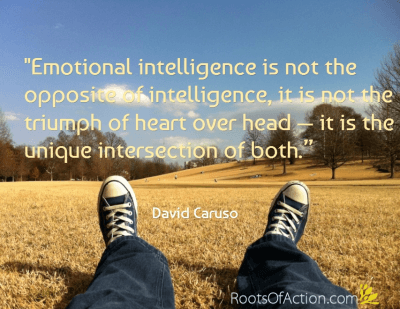
What is emotional intelligence? How do parents and teachers nurture it at home and in the classroom? What methods are working?
Emotional intelligence (EI for short) has become a popular term since Daniel Goleman authored his book with the same title in 1995. Several decades of research not only confirms the importance of teaching kids to understand and manage their emotions, but also suggests that emotional intelligence is predictive of future success in life. “It is very important to understand,” says psychologist David Caruso, “that emotional intelligence is not the opposite of intelligence, it is not the triumph of heart over head — it is the unique intersection of both.”
While we know how important emotional intelligence is for kid’s happiness and well-being, it’s been difficult to get experts to agree on the best ways to teach these skills to children. In an excellent New York Times article, Can Emotional Intelligence Be Taught, Jennifer Kahn, professor at the University of California, identifies some of the challenges of teaching what is often called social and emotional learning.
The teaching of emotional intelligence is complex. Parents and teachers need to understand and be able to manage their own emotions in order for a child to model effective behaviors and connect to caregivers on deep emotional levels. It is at these deeper levels of understanding that positive changes in the brain occur. The issue I find with many social and emotional learning programs is their sole focus on thinking.
What is emotional intelligence about, really? It’s about the connection we feel between body, mind, and spirit – and how we make sense of sensations, thoughts, and feelings. That connection is a critical aspect of social and emotional learning and in stimulating the brain’s neuroplasticity.
A quick Internet search will give K-6 parents and teachers lots of information about emotional intelligence and about the many programs being tested in schools on how best to instill these abilities. We can’t wait for another decade of research to be completed. There are excellent ways families and teachers can begin to create a culture that builds emotional intelligence in homes and classrooms right now.
One of the most promising programs I’ve seen in recent years is also a simple one to bring into your home or class. It’s called the Toolbox™ and was developed by Dovetail Learning. Watch this video and you’ll see the toolbox in action with a classroom of elementary-school kids!
What is Emotional Intelligence?
This Toolbox Helps Parents, Kids, and Teachers Learn EI from the Inside Out!
When I first learned about the Toolbox™ in early 2014, it was being piloted in a small group of schools as research was conducted on its effectiveness. Today, it is being used in 81 cities and 16 states, serving over 100,000 students. Dovetail Learning offers an array of information for anyone wanting to help kids develop emotional intelligence. They even provide a downloadable handout of the 12 tools so you and your children or classroom can get inspired to use them! The tools are simple yet extremely powerful!
What is emotional intelligence at home? In the classroom? Use these tools to discover the power of EI for yourself, your children, or your students!
1. Breathing Tool teaches children to calm themselves, check-in with their bodies, and reflect to discover what’s best for them and others.
2. Quiet/Safe Place Tool helps kids find respite and safety when they need to withdraw and find their natural rhythm.
3. Listening Tool reminds children to listen with all of their senses, including their hearts.
4. Empathy Tool encourages kids to let go of their own perspectives long enough to acknowledge other people’s thoughts and feelings.
5. Personal Space Tool teaches children how to appreciate their own and other people’s boundaries.
6. Using Our Words Tool helps children understand that the words they choose make a difference to the relationships they create.
7. Garbage Can Tool allows kids to discard the unkind words and actions of others and focus on what has the most meaning to them.
8. Taking Time Tool gives children permission to choose time wisely, in ways that help them self-reflect and understand others.
9. Please and Thank You Tool instills those magic words that show respect to others and invites people into deeper connections.
10. Apology and Forgiveness Tool reminds children that mistakes are a vehicle for learning and how important it is to let go of blame and resentment.
11. Patience Tool helps kids understand that they are strong enough to wait – a valuable skill that helps children learn to manage their emotions.
12. Courage Tool teaches children to stand up for what is right, even when other’s aren’t watching.
I love the way these tools answer the question, “What is emotional intelligence and how can I practice it everyday?” When used wisely, parents with elementary-age children, parents who are homeschooling and K-6 teachers can use these tools to help build a culture of emotional intelligence.
Suggestions for Applying the Toolbox Today!
- Work with your children to make a deck of toolbox cards or create a key-chained grouping of them similar to the video.
- Talk about each tool as you create them – this will help children get a general feel for the whole toolbox.
- Focus on ONE tool each week for practice. Adults and children should both practice using the tools. Learning is a two-way street! You learn from each other.
- As each week progresses, add ONE more tool for practice during the week as you build a repertoire for using all of them. Adults help children by suggesting a specific tool that would be useful in certain situations.
- Have a weekly check-in where you talk about what’s going well and what needs more work. How are you using the toolbox? How does it help you? How can it be misused? How are your relationships improving? During this time, help children more fully understand each tool.
- Be sure to give feedback to each other and share encouraging words for kids that tie their efforts to their successes!
- At the end of three months, your family or classroom will have lots of experience using your own toolbox of social and emotional skills! Continue using them until they become a natural part of your social culture.
One of the things I love about these tools is that they are used by children AND the adults in their lives! Yes, we adults need practice too! The toolbox gives everyone a simple, common, and easily-remembered way of using the abilities that make our brains healthy!
As you create your toolboxes, please share your experiences with us at Roots of Action. We’d love to learn from you!
Reference
Freedman, J. (2009). Emotional what? Definitions and history of emotional intelligence. (Quote from David Caruso)
This article was first published February 16, 2014 and updated to reflect new information on November 15, 2017.
Image Credit: Auremar
Published: November 15, 2017
Tags: character strengths, classroom practices, empathy, failure, gratitude, learning, parenting, positive values, positive youth development, teachers



